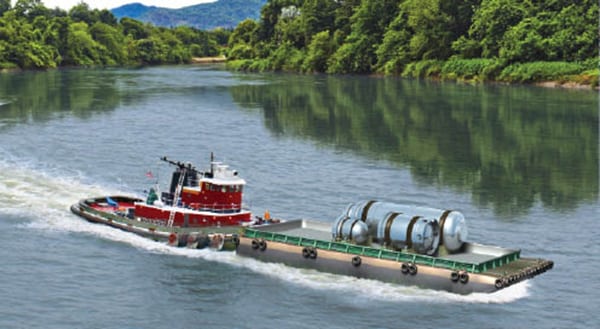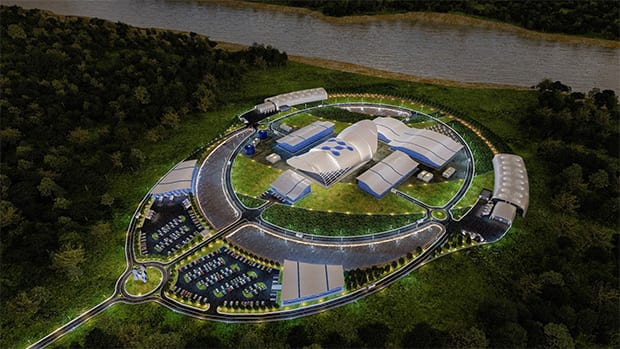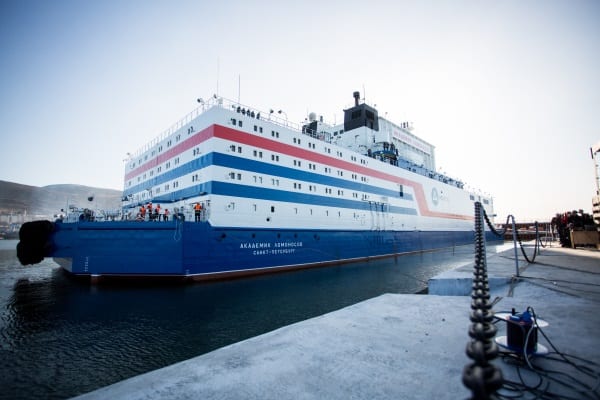NuScale Exploring Marine-Deployed SMR Power Plant
The post NuScale Exploring Marine-Deployed SMR Power Plant appeared first on POWER Magazine.

NuScale Power and Prodigy Clean Energy, a Canadian designer of small modular reactor (SMR) marine power stations, have completed the conceptual design and economic assessment phases of a potential marine-deployed" NuScale Power module (NPM) nuclear power plant.
Building on an August 2018 memorandum of understanding (MoU) in which the companies set out toinvestigate the technical and economic feasibility of integrating the NPM into Prodigy's Marine Power Stations, the companies are now working together, under a new MoU signed on May 14, to support business development opportunities to engage customers and develop demonstration and commercial opportunities internationally." The MoU envisions an SMR power plant that could potentially provide baseload power for coastal locations and island nations, NuScale said.
NuScale declined to detail outcomes of its conceptual design work, citing non-disclosure agreements. Generally, however, marine-deployed NPMs would be of the same design, safety case, operation, and performance as the NPMs" that will be used for the Carbon Free Power Project (CFPP) at Idaho National Laboratory in Idaho Falls, Diane Hughes, NuScale vice president for Marketing and Communications, told POWER on May 18.
The CFPP is a potential 720-MWe NuScale plant that interlocal agency Utah Associated Municipal Power Systems (UAMPS) is spearheading, and if it begins operations by 2029, as UAMPS anticipates, it could become the first commercial SMR power plant in the U.S.
 An artist's rendering of a terrestrial NuScale SMR site. Courtesy: NuScale PowerShipyard-Fabricated, Transported by Sea, and Berthed
An artist's rendering of a terrestrial NuScale SMR site. Courtesy: NuScale PowerShipyard-Fabricated, Transported by Sea, and BerthedWhat is primarily different between the land and marine-based applications is the structure in which the NPMs and other equipment are housed, and the spatial arrangement of some of the power plant equipment," Hughes said.
As opposed to a land-based nuclear build, the Marine Power Station would be shipyard-fabricated, and marine-transported to its deployment location, where it would be moored in place in sheltered and protected waters at the shoreline. Once berthed, the plant would be connected to the existing shore-side transmission system," she said.
A marine-deployed plant would be tailored to customer requirements, integrating anywhere from 2-12 NPMs." Also, since the marine plant is mobile, it could be towed either for redeployment at a secondary location before NPM end-of-life, or for decommissioning at a dedicated facility at NPM end-of-life," Hughes noted. While this flexibility could eliminate a sizable land footprint, connecting the plant to existing shore-side infrastructure will also avoid significant capital costs associated with terrestrial nuclear power plant deployments." Prodigy's turnkey solutions would also translate to lower costs and shorter schedules in comparison to land-based deployments, NuScale said.
These design features, coupled with the fact that the marine plant is seismically isolated, means that we will have an opportunity to bring affordable, safer, reliable, and zero-emissions power to coastal locations worldwide, including to locations where traditional terrestrial nuclear plants can't be built," Hughes added. Our project will significantly broaden market opportunities for nuclear power and expand NuScale's ability to bring carbon-free energy to all parts of the world."
A First-of-Its-Kind Concept-for North AmericaIf built, a floating NuScale plant would be pioneering in North America. While floating power plants have been widely used for decades as a source of flexible, decentralized power generation, the only purpose-built floating nuclear power plant is the 70-MWe/58-MWth Akademik Lomonosov, in Pevek, Chukotka, in Russia's Far East. Russia's state-owned nuclear company Rosatom officially began operating that project in May 2020. The plant includes coastal infrastructure and a floating power plant unit that is outfitted with two 35-MW KLT-40S reactors. It provides power to mining projects as a replacement for the region's retiring Chaunskaya fossil fuel power plant and the Bilibino nuclear power plant.
Rosatom has not disclosed that project's costs, though it has said that when it designed its SMRs, it compared their economics with conventional generation sources like coal or gas to ensure its competitiveness." Rosatom also stressed that so-called first-of-a-kind" (FOAK) projects will be more expensive and take longer to build than subsequent serial projects will." It added: This rule is not just applicable to the nuclear industry but was also true of the first solar panels ever constructed. Cost reduction comes with the economies of scale and the learning curve."
 The Akademik Lomonosov, a pioneering floating nuclear power plant, was fully commissioned in Pevek, Chukotka region in the Russian Far East in May 2020. The plant includes coastal infrastructure and a floating power unit equipped with two KLT-40S reactors of 35e MW each. The plant's total power capacity is 70 MWe while its heat capacity is 50 Gcal/h. The plant's length is 140 meters, its width is 30 meters, and its displacement is 21,500 tons. The service life is 40 years. Courtesy: Rosatom
The Akademik Lomonosov, a pioneering floating nuclear power plant, was fully commissioned in Pevek, Chukotka region in the Russian Far East in May 2020. The plant includes coastal infrastructure and a floating power unit equipped with two KLT-40S reactors of 35e MW each. The plant's total power capacity is 70 MWe while its heat capacity is 50 Gcal/h. The plant's length is 140 meters, its width is 30 meters, and its displacement is 21,500 tons. The service life is 40 years. Courtesy: RosatomOther countries reportedly considering floating nuclear power plants include China, which announced it would build a floating nuclear project using a 600-MWe/200 MWth ACPR50S reactor in 2016. South Korea's Kepco Engineering & Construction Co. in October 2020, meanwhile, signed an MoU to cooperate on the development of floating nuclear power plants with Daewoo Shipbuilding & Marine Engineering. The agreement is designed to advance floating plants equipped with BANDI-60 SMRs, which Kepco has been developing since 2016.
Asked what NuScale and Prodigy's economic feasibility assessment for the marine-deployed NPM concept revealed, Hughes said its outcomes are also subject to non-disclosure agreements." But she noted, the combination of NuScale's factory-fabricated SMR with Prodigy's shipyard-fabricated Marine Power Station is showing highly favorable cost figures in comparison to land-based nuclear power plant projects."
Prodigy Developing Turnkey Nuclear Power SolutionsIn a statement on May 14, NuScale said Prodigy specializes in integrating commercial SMRs into marine power plant systems for coastal power generation." Prodigy, which is one of several firms that signed onto Canada's December 2020 SMR Action Plan, says it is developing turnkey nuclear power solutions to fit a niche but growing commercial market for remote and off-grid power generation. It added that it has a current and developing" domestic and international project portfolio with near-term delivery schedules in the mid to late 2020s."
As part of its endorsement of the SMR Action Plan, Prodigy suggested its FOAK SMR and microreactor power plants are tailored to the unique environmental, climate, and infrastructural needs" of remote locations like the Canadian North, where indigenous communities depend almost exclusively on diesel fuel for power generation. The company's commercial approach is to develop SMR and microreactor power plants and business constructs tailored to the specific operating and economic needs of the customer," it said. Its business offerings include optimized plant siting, deployment, and overall plant lifecycle management strategies. The model will help end-users, local communities, and other stakeholders stay within prescribed" policy, regulatory, and legal boundaries, it said.
According to Hughes, NuScale and Prodigy will support customer engagement efforts to develop demonstration and commercial opportunities," under their latest MoU. Their customer engagements, however, are also presently subject to non-disclosure agreements," she said.
NuScale Gains Major InvestmentsSMR deployments for coastal power generation mark yet another new direction for NuScale, which is eyeing a 2027 technology delivery timetable and has already marked notable licensing in-roads. On Aug. 28, 2020, NuScale's 50-MWe (160 MWth) module became the first SMR to receive a final safety evaluation report (FSER) from the Nuclear Regulatory Commission (NRC) as part of a Phase 6 review-the last and final phase-of NuScale's Design Certification Application (DCA). It has since boosted the NPM's capacity to 77 MW.
In January, NuScale and Fluor Corp., its majority investor, executed a series of major agreements with UAMPS to prepare for NRC licensing of the CFPP, marking a new milestone for the much-watched project. UAMPS, however, told POWER on Tuesday it is still evaluating its options to build a 308-MWe four-module or a 462-MWe six-module plant instead of a 720-MWe 12-module plant.
Meanwhile, Fluor and NuScale are ramping up engagement with potential customers, capital investors, manufacturers, and other supply chain partners for NuScale SMR deployment efforts. Investor interest in the company continues to grow. In April, joining several other core investors that are backing the company, JGC Holdings Corp. of Japan invested $40 million into NuScale Power. JGC will also become a global strategic engineering, procurement and construction (EPC) partner for new SMR projects," Fluor said.
On May 7, NuScale also announced it had retained financial advisory and capital markets firm Guggenheim Securities to evaluate the right options to raise additional capital and accelerate the development" of the NPM technology, said John Hopkins, NuScale chairman and CEO. NuScale said that it expects to use any proceeds raised through that process to expand its SMR development program," including elements supported by the Department of Energy's $1.355 billion, 10-year award for the UAMPS project.
-Sonal Patel is a POWER senior associate editor (@sonalcpatel, @POWERmagazine).
The post NuScale Exploring Marine-Deployed SMR Power Plant appeared first on POWER Magazine.